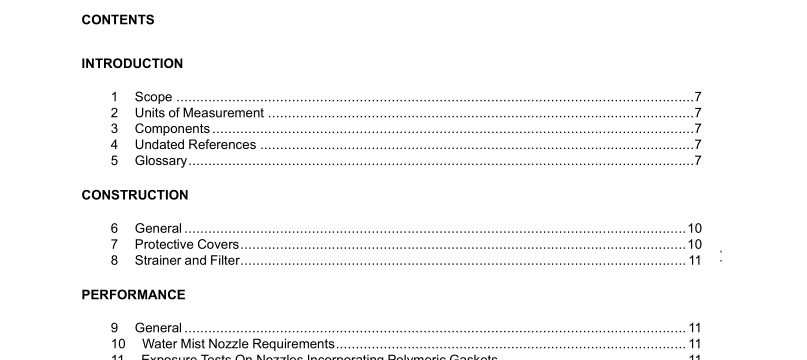UL 2167-2021 pdf download.Water Mist Nozzles for Fire Protection Service.
50.9 Test procedure 50.9.1 The fire tests are to be conducted with nozzles having the highest temperature rating at their maximum spacing and maximum distance below the ceiling as specified in the manufacturer’s design and installation instructions. 50.9.2 The ignition source for the fire test is to consist of 0.68 kg (1.5 lb) of shredded newspaper on the floor adjacent to the cartons in the corner as illustrated in Figure 50.1. After ignition, water is to be supplied to the nozzles at their minimum operating pressure. 50.9.3 The fire test is to be conducted for 30 minutes or until the fire is extinguished. 50.9.4 At the completion of the 30 minute test, the water is to be shut off and any remaining fires extinguished. The cartons are then to be examined visually to determine compliance with the requirements specified in 50.6.1.
51 Production Leakage Test 51.1 The manufacturer shall provide regular production control, inspection, and tests. The program shall include the test specified in 51.2, for each automatic nozzle. 51.2 Automatic nozzles shall not leak when subjected to a minimum hydrostatic pressure of 3.45 MPa (500 psi), or twice the rated pressure, whichever is greater, maintained for a period of no less than 2 seconds. 52 Glass Bulb Integrity Test 52.1 After being subjected to the production leakage test, a glass bulb nozzle assembly shall be evaluated for integrity of the glass bulb for cracking, breaking, or other damage as indicated by the loss of fluid. For example, the bubble in each glass bulb shall be examined at room ambient temperature. The nozzle shall then be heated in a circulating air oven or liquid bath to 5 °C below the minimum operating temperature range of the sprinkler. The bubble shall then be examined to determine the bubble size has been reduced in accordance with the glass bulb manufacturer’s specifications. After cooling, the bubble size shall again be examined to determine the bubble returned to the original size within the tolerance allowed by the glass bulb manufacturer. INSTRUCTIONS 53 Design and Installation Instructions 53.1 A copy of the manufacturer’s design and installation instructions shall be furnished for use as a reference in the examination and testing of water mist nozzles.
54.2 With reference to 54.1 (d), the nominal year of manufacture includes the last three months of the preceding year and the first six months of the following year. 54.3 Except for coated and plated nozzles, the nominal operating temperature range shall be color- coded on the nozzle to identify the nominal rating and shall be in accordance with Table 12.1. The color code shall be visible on the yoke arms holding the distribution plate for fusible element nozzles, and shall be indicated by the color of the liquid in glass bulbs. All nozzles shall be stamped, cast, engraved, or color- coded in such a way that the nominal rating is recognizable even when the nozzle has operated. 54.4 In countries where color-coding of yoke arms of glass bulb nozzles is required, the color code for fusible element nozzles shall be used. 54.5 Recessed housings, when provided, shall be marked for use with the corresponding nozzles unless the housing is a non-removable part of the nozzle. 54.6 Protective covers shall be orange in color and shall be marked to indicate that the cover must be removed before the nozzle system is placed in service. The marking shall be placed on the cover so it is visible after nozzle installation.
SUPPLEMENT SB – NOTES ON THE STRENGTH TEST FOR NOZZLE RELEASE ELEMENTS (Informative) The formula given in 21.2 is based on the intention of providing fusible elements that are not susceptible to failure resulting from creep stresses during a reasonable period of service. The duration of 876,600 hours (100 years) was specified only as a statistical value with an ample safety factor. No other significance is intended as many other factors govern the useful life of a nozzle. Loads causing failure by creep, and not by an unnecessarily high initial distortion stress, are applied and the times noted. The given requirement then approximates to the extrapolation of the full logarithmic regression curve by means of the following analysis.UL 2167-2021 pdf download.
UL 2167-2021 pdf download
